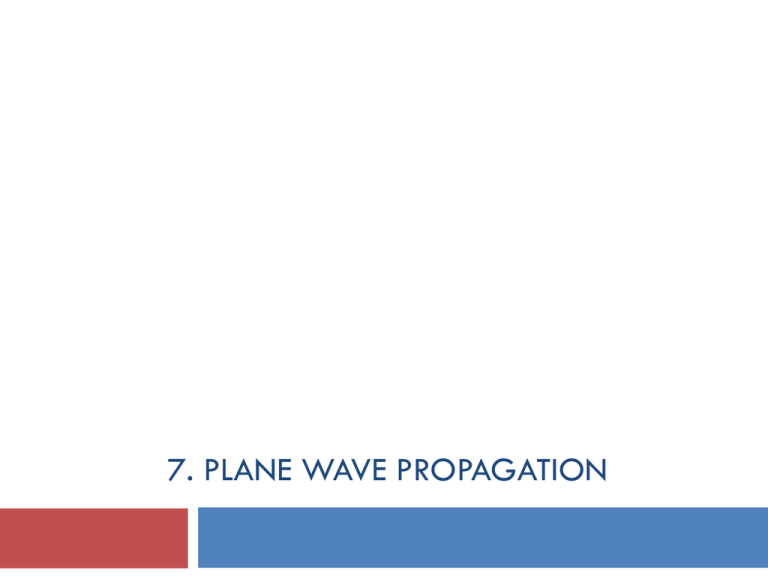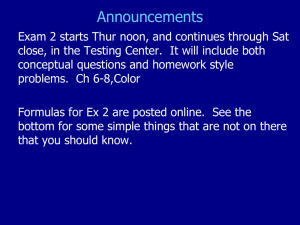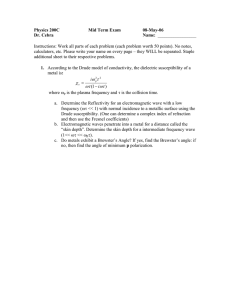Plane-wave Propagation - Sonoma State University
advertisement

7. PLANE WAVE PROPAGATION Review We have learned about wave propagation Guided propagation Skywave [f=3-3- Mhz] Cable Transmission Line Reflected wave Constructive Parameters Standing waves Wave equation Time representation Phasor representation Propagation constant We have been assuming TEM waves: Direction of propagation is in Z E is in r direction H is radial Sky Wave (Skip) Propagation EM Waves can be unguided: 1. EM Source radiates Spherical wave 2. Spherical wave Planer wave (far-field effect) 3. Planer waves are uniform 4. We consider TEM waves Unbounded EM Waves Planer Waves Unbounded EM Waves: 1. Waves are traveling in dielectric (perfect dielectric lossless media) 2. We use wave equations instead of transmission line equations 3. We refer to intrinsic impedance rather than characteristic impedance, Zo 4. Propagation constant = loss + Phase constant 5. k = wave number (same as phase constant in transmission line) We start by considering phasor form! Review of Maxwell’s Equations THIS IS WHAT WE HAVE LEARNED SO FAR…… We now express these in phasor form. HOW? Review of Maxwell’s Equations – General Form All the fields are in phasor form Time derivatives are expressed differently:d/dt jw Maxwell’s Equations – Free Space Set We assume there are no charges in free space and thus, =0 Time-varying E and H cannot exist independently! If dE/dt non-zero dD/dt is non-zero Curl of H is nonzero H is non-zero If H is a function of time E must exist! Maxwell’s Equations – Free Space Set We assume there are no charges in free space and thus, =0 Phasor Form We will use these to derive the wave equation for EM waves. Wave Equations Assume no volume charges Complex permittivity For electrostatic Del of E is zero Special Property: Laplacian of E Homogeneous Wave Equations for E and H Propagation Constant: Complex permittivity Similarly: Similarly: Homogeneous Wave Equations for E and H (Lossless case) Propagation Constant: Note: if lossless conductivity =0 Complex permittivity Similarly: Our assumption was having a uniform plane There is no change of field For example, in x-y plane: dE/dx = dE/dy = 0 Uniform Plane Wave (x-y plane) Consider vector field E: Must satisfy There is no change in X and Y (uniform) Same thing for Ey and Ez: Only non-zero vector component Same thing for Ey and Ez: Uniform Plane Wave (x-y plane) Solution Note A Application of yields: General Form of the Solution: Propagating in +Z Propagating in -Z Summary: This is a plane wave with For a wave travelling along +z only: with Power and Impedance k (x,y,z) E (x,y,z) H (x,y,z) Intrinsic Impedance of a lossless medium (analogy to Zo) Phasor Form Remember: HEK Time Domain Representation TEM Traveling Wave Solution Time-Domain Solution Check the Simulator Directional Relation Between E and H For Any TEM Wave k (x,y,z) E (x,y,z) H (x,y,z) Phasor Form Note: E and H may have x & y components However, they travel in Z direction and They are perpendicular to each other! Example What is k? (it is a function of what? Which direction is it pointing at?) What is E? What is H? k (x,y,z) (HEK) E (x,y,z) H (x,y,z) Note B Example Find l, k, E(z,t), H(z,t) Notes B Example cont. Check out the Simulator Polarization - General Polarization is the orientation of electric field component of an electromagnetic wave relative to the Earth’s surface. Polarization is important to get the maximum performance from the antennas There are different types of polarization (depending on existence and changes of different electric fields) Linear Horizontal (E field changing in parallel with respect to earth’s surface) Vertical (E field going up/down with respect to earth’s surface) Dual polarized Circular (Ex and Ey) Similar to satellite communications TX and RX antennas must agree on direction of rotation Elliptical Linear polarization is used in WiFi communications Polarization can change as the signal travels away from the source! -Due to the magnetic field of Earth (results in Faraday rotation) -Due to reflection Polarization - General (x,z) z E-Field is Going up/down respect to Earth! (Vertical Polarization) (y,z) E-Field is Rotating (or Corkscrewed) as they are traveling Propagating parallel to earth Polarization is important to get the maximum performance from the antennas The polarization of the antennas at both ends of the path must use the same polarization This is particularly important when the transmitted power is limited Wave Polarization See Notes Wave Polarization Plane wave propagating along +z : If: Delta = Angle difference then Polarization State Polarization state describes the trace of E as a function of time at a fixed z Time domain representation Magnitude of E Inclination Angle psi Linear Polarization: or In-phase Out-of-phase E traces a line( in blue) as the wave traverses a fixed plane Circular Polarization LHP: RHP: LH Circular Polarization Magnitude Inclination Angle RH Circular Polarization: Example See notes LCD Liquid Cristal Molecular spiral Operation of a Single Pixel 5 micron LCD 2-D Array
![Hints to Assignment #12 -- 8.022 [1] Lorentz invariance and waves](http://s2.studylib.net/store/data/013604158_1-7e1df448685f7171dc85ce54d29f68de-300x300.png)





